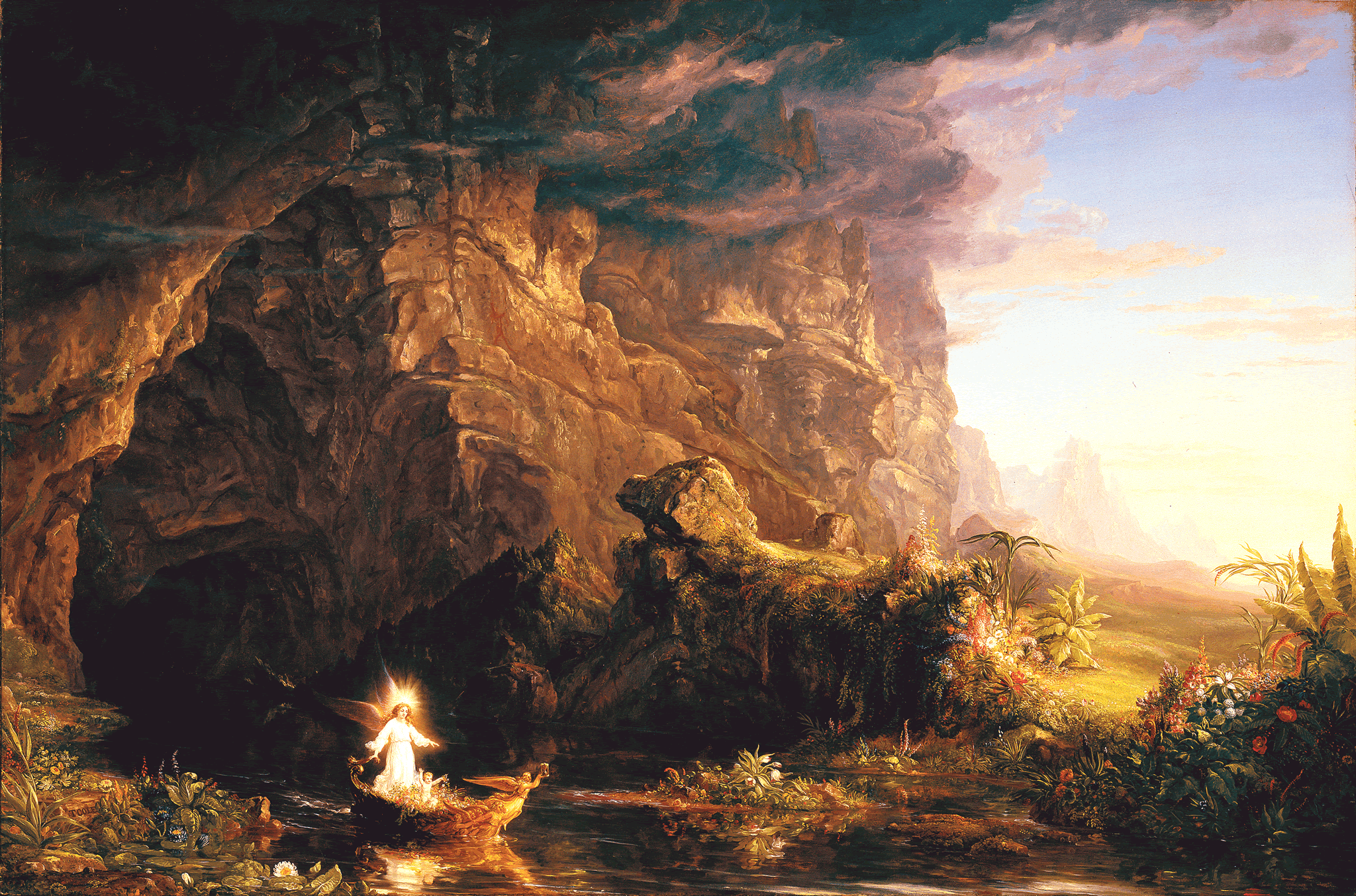The Voyage of Life: Childhood (First Set)

About
Decode
Compare
Cole's Process
Cole's Words
Locate
About
"CHILDHOOD—A stream is seen issuing from a deep cavern, in the side of a craggy and precipitous mountain, whose summit is hidden in clouds. From out the cave glides a Boat, whose golden prow and sides are sculptured into figures of the Hours. Steered by an Angelic Form, and laden with buds and flowers, it bears a laughing Infant, the Voyager, whose varied course the Artist has attempted to delineate. On either hand, the banks of the stream are clothed in luxuriant herbage and flowers. The rising sun bathes the mountains and flowery banks with rosy light.
The dark cavern is emblematic of our earthly origin, and the mysterious Past. The Boat, composed of Figures of the Hours, images the thought, that we are borne on the hours down the Stream of Life. The Boat identifies the subject in each picture. The rosy light of the morning, the luxuriant flowers and plants, are emblems of the joyousness of early life. The close banks, and the limited scope of the scene, indicate the narrow experience of Childhood, and the nature of its pleasures and desires. The Egyptian Lotus, in the foreground of the picture, is symbolical of Human Life. Joyousness and wonder are the characteristic emotions of childhood. 1
Decode
Mouse over the detail to view its caption, click it to zoom in, and use the reset button on the lower right to zoom back out.
1. A guardian angel steers a golden ship holding a happy infant (the Voyager). Cole's son Theddy, who was two years old at the time Childhoodwas painted, may have been a model for the young Voyager.
2. The prow of the boat is an angel holding an hourglass, which is full at this stage in the Voyager's life. The angelic figures carved on the sides of the boat are what Cole described as the "Figures of the Hours," linking mortality and time.
3. This flower is an Egyptian lotus, which Cole described as "symbolical of Human Life."
4. The boat emerging from the dark cave represents birth. Cole's daughter Mary was born during the creation of Childhood, and this event may have influenced his conception of the scene.
5. Flowers grow on the riverbanks, representing spring and new growth. The close proximity of the flowers and the limited landscape suggest a child's narrow scope of vision.
6. Light enters from the east and signifies the time of day as early morning.
Compare
John Halpin, The Voyage of Life: Childhood, engraving after Thomas Cole, 1852, 3 ¼ x 5 1/16 in. Dr. and Mrs. Charles A. Sarnoff, Great Neck, NY. View in Scrapbook
Many artists, including Halpin, Robert Hinshelwood, and James Smillie, made engravings after Cole's The Voyage of Life because of its popular Christian subject matter. Halpin's engraving of Childhood, along with the three other paintings, was included in a book entitled The Voyage of Life; Suggested by Cole's Celebrated Allegorical Paintings, published by Rev. Jared B. Waterbury in 1852. The publication of such a volume suggests the widespread influence of Cole's artwork on the religious community, and this book instructed readers on how to lead a proper Christian life in four stages, just as in the artist's series. The engraving replicates Cole's painting in composition, although it is less detailed, making the image more suitable for mass production. 1
Process
Cole wrote of his intention to paint an "Allegory of Human Life—a series" in the list of themes and subjects he started in 1827. He began jotting down his ideas for the first painting of The Voyage of Life years before it was actually painted, making a sequence of preliminary drawings and small oil studies that allowed him to work out the series' mood, color, and composition, before turning to the large canvases. In this early sketch, Cole drew on the back of a letter, rather than in his sketchbook, suggesting a sudden burst of inspiration. Hurried, scribbled contour lines mark the position of the cave, river, and boat with figures, anticipating the composition of the final painting.
In designing The Voyage of Life, Cole combined the original concepts for the series with numerous en plein airand studio sketches. Cole favored broad diagonal arrangements for each composition. He transferred the preliminary drawings to the canvases as a blueprint for the four interrelated works. The underdrawings in many cases are painstakingly rendered with the aid of rulers and compasses. 1
Cole was methodical in applying paint, starting with a thin and even application of an additional ground to the already prepared supports in order to harmonize his distinctive color palette. He favored warm colors for his grounds, often using a salmon-buff or reddish-brown hue. 2 Sometimes he applied the paint quite thinly, but he varied the density of his pigments—they are especially thick in the bright highlights. The final step was to apply a layer of transparent varnish that provided a lustrous protective coating for the paint surface.
Works
1. Thomas Cole, Preliminary Sketch for The Voyage of Life: Childhood, ink on paper, c. 1837-39, 6 x 7 7/8 in. Albany Institute of History and Art. View in Virtual Gallery
2. Thomas Cole, The Voyage of Life: Childhood (First Set), oil on canvas, 1839-40, 52 x 78 in. Munson-Williams-Proctor Arts Institute, Utica, NY, 55.105.
Words
This world of the mind is a mere created point in infancy; it increases with the hours[,] the months & the years until the middle of life; then as old age advances the links are loosened one by one, the accumulated materials fall away, the latest first & so on to those of infancy which as being the first, cling to the retiring point with the greatest tenacity to the last. 1
Find it here.
